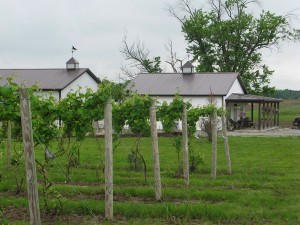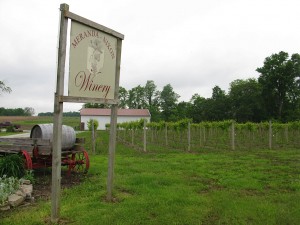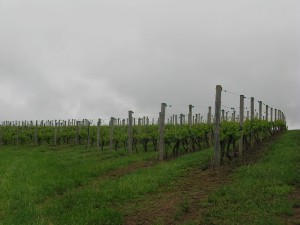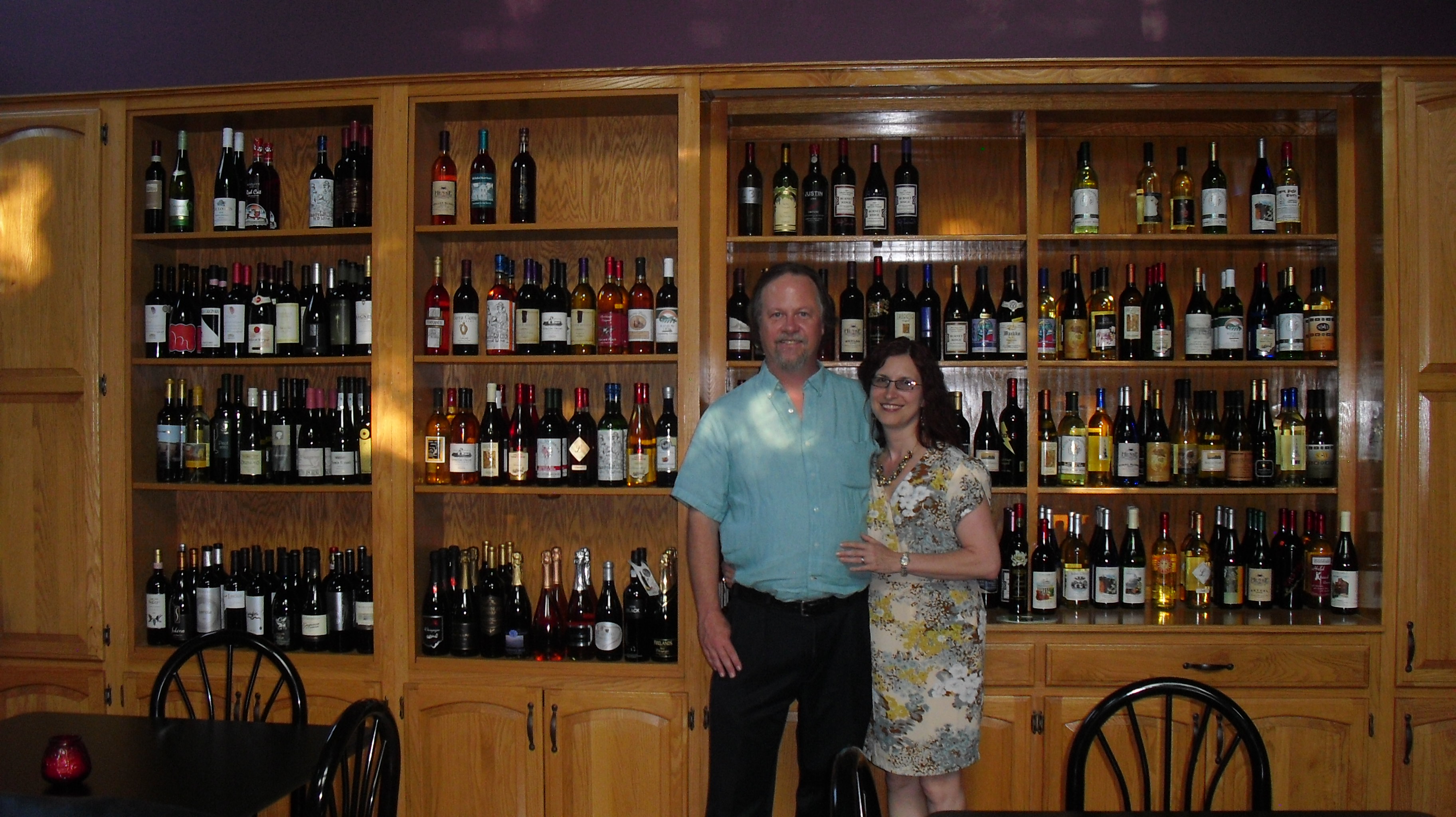Southern Ohio Wine Renaissance
For the last 10 years, southern Ohio has been carefully rebuilding its reputation as a premiere wine-growing area — a title it once held more than one hundred years ago when the Ohio River Valley was known as the nation’s wine capital, and its largest wine grower, Nicholas Longworth, was known as the ‘Father of American wines.”
Credit the area’s fertile limestone soils, a moderate climate and gently rolling topography for its success with wine grapes. Yet by the mid-1800s, the southern Ohio wine industry was gone, defeated by a one-two punch of black rot and powdery mildew which decimated vines and caused wine growers to move elsewhere.
However, the area is once again thriving as a wine region, producing award-winning Cabernets and other vinifera wines. How the renaissance occurred (and continues to occur) is a tale told best by two individuals — Ron Barrett, who along with partner Nancy Bentley, owns Kinkead Ridge Winery, and Tina Meranda, who co-owns the Meranda-Nixon Winery with her husband Seth.
Kinkead Ridge Winery
Ron Barrett had been growing and producing Pinot Noir for years in Oregon when he and Bentley decided in the late 1990s that they needed a new challenge, someplace they could go to grow a variety of vinifera grapes, not just Pinot Noir. Bentley researched three areas as possible sites for a new winery — eastern Washington, southern Oregon and southern Ohio. Ohio’s unglaciated, limestone soil and its proximity to the Ohio River is what swayed the couple to move east. Barrett’s goal was to grow world-class vinifera grapes, and in that, he’s been successful. His 2008 Cabernet Sauvignon, released last year, earned a Gold Medal at the 2011 Finger Lakes Competition and, in 2010, a Wine of Merit title from Virginia’s prestigious Jefferson Cup Invitational. Kinkead’s Cabernet Franc, Syrah and Viognier/Rousanne have all been highly praised by experts across the country.
Barrett began his vinifera-only vineyard with registered, certified root stock from his Oregon vineyard, but over the years he has bought root stock from Kendall-Jackson as well.
Hybrid grapes would be easier to grow, Barret admits. ‘There is so much effort in growing vinifera,” he says — but he makes the effort because he prefers making and drinking vinifera varieties.
To keep Kinkead Ridge’s vinifera-only vineyards healthy and productive, Barrett pays attention to detail. ‘Pre-plant decisions are important,” he says, which includes the soil, its pH content and condition. ‘Winter-hearty soils are not satisfactory for wine grapes.” This is especially true for vinifera or susceptible hybrids, he says.
Barrett plants grapes in rows 7.5 feet apart. Once the vines are in, the most important activity then becomes canopy management. ‘You need to get ahead of the vines and stay on top of them,” says Barrett. ‘Don’t let your shoots overlap because if you can’t see the grapes, neither can the sun.” Everything is cane pruned, says Barrett. ‘It’s labor-intensive work so few vineyards do it, but it makes a more even shoot distribution in your canopy.” Once June hits, vines ‘explode” says Barrett, and if you haven’t taken control of your canopy at this point, you’d better have the resources and commitment to catch up. By the end of July, it’s too late. ‘Poor canopy management is the number one reason for vineyard failure,” he says. An uncontrolled canopy not only means a lack of sunlight on the grapes, but an increase in disease and pest presence as well.
Barrett begins his spraying in the spring and applies pest-management rigorously throughout the growing season ‘Spend money on a good sprayer,” he adds.
Grapes are picked between Sept. 15 and 20 through late October or Nov. 1. ‘The additional hang time is valuable,” he says. ‘The flavors of the grape mature and fully ripen.” The alcohol level also rises, but it’s the full maturity of the grapes, especially the Cabernet Sauvignon, that Barrett is after. He makes a point of training his pickers so most of the sorting is done in the field, and once trained, he does his best to retain them. Pickers at Kinkead Ridge make ‘in excess of $20 an hour,” says Barrett.
When it comes to actual wine production, Barrett does little to interfere with Mother Nature. He uses isinglass (dried fish bladder) as well as egg whites to clarify his wines and reduce their herbaceous qualities, and while expensive, he also uses BECO filters — not only for their ‘green” factor (they’re manufactured from all-cellulose) but because there is better through-put, meaning less importation of flavors and less wine loss. ‘They pay for themselves,” he says. He uses both French and American oak barrels to age his red wines, and ferments the juice for a year and a half.
The Kinkead Ridge winery is separated by distance from the vineyards because of a state law forbidding auxiliary tasting rooms. The winery was built from scratch, however, and is located off the main street in Ripley, Ohio. Production and sales occur in the same building. Generally, Kinkead Ridge produces between 1,500 and 1,800 cases of wine a year. ‘It’s about a 55 to 45 ratio, reds to whites,” says Barrett. A good 70 percent of Kinkead Ridge wines go to wholesale buyers, which can leave tasting room buyers disappointed. The winery frequently sells out of its available retail wines within six months of release.
Barrett has mentored many new wine-makers in the area, and his Web site, www.kinkeadridge.com is packed with technical information on both viticulture and enology. His best advice for those wanting to become wine growers or makers is this: ‘Decide who you want to be.” In other words, says Nancy Bentley, decide on your marketing model. If you want to become a destination winery, then look into other activities you can add to your business, including food, music, or weddings. If you want to focus on viniferas or hybrids, do it, but do it well.
By the time you read this, it’s likely that Barrett and Bentley have retired. At the time of this writing, they were actively seeking a buyer for Kinkead Ridge. It won’t be just anyone though, says Barrett. ‘We’re looking for someone who is as passionate about wine as we are.”
Meranda-Nixon Winery
That passion can already be found with some of the southern Ohio winery owners mentored by Barrett and Bentley. One of those wineries is the nearby Meranda-Nixon winery.
In a sense, Meranda-Nixon was born out of necessity as much as passion. Southern Ohio, especially the area around Ripley, was a tobacco-growing area, and for five generations, that was the Meranda family’s chief crop. But as the government began to cut back on tobacco subsidies, farmers began to look for other crops to grow — and wine grapes were rapidly becoming the hot new cash crop. Seth and Tina Meranda switched from tobacco to grapes in 2003.
Even still, says Tina Meranda, who grew up on a farm in nearby Warren County, it took three years to begin to bring in the kind of money that generations of Merandas had brought in with tobacco. ‘We had to invest in the tanks and the other wine-making equipment,” she says — but the land, at least, was already theirs, an elevated area just two miles from the Ohio River by air. Because their soil is both glaciated and unglaciated, the Merandas have chosen to grow both vinifera and hybrid varieties, and, like Barrett, the Mirandas have purchased rootstock from Kendall-Jackson as well as other New York vineyards. The Merandas like the 3309 Kendall Jackson riparian rootstock because it resists crown gall which can be a problem in locations with cold winters. ‘We tried the 10114 rootstock because it was recommended,” says Meranda. ‘But we found it wasn’t good with our soil.”
Tina Meranda plants the grapes by hand, using an augur. She spaces the vines a little further than Barrett — about 8.5 feet apart. It’s labor-intensive and time-consuming, but Meranda won’t compromise. ‘The human hand is better at this task than a machine,” she says. The tender, young vinifera vines are hilled up when planted — protecting them against Ohio’s cold winters. ‘We don’t hill up the varietals because they’re hardier;” she says. All of the vines benefit from the warming effect of the Ohio River — the same warming effect the Great Lakes provide growers up north. ‘The river heats up in the summer, and keeps the temperatures in the area above freezing when the cold weather hits,” she says.
The Merandas have heeded their mentor’s advice and are careful to control their canopy early. ‘We pull the leaves on the east side so the sun can reach the grapes,” Meranda says. ‘The eastern sun isn’t as strong as the west, and there are fewer sun hours,” so exposing the grapes on that side is important.
Grapes here are grown sustainably, using both organic and traditional methods of pest control. Their greatest pest is the Lady Asian beetle, says Meranda. ‘We spray throughout the season, up until a few weeks before harvest,” she says.
The Merandas pick their grapes starting in September. By mid-September, they’re picking their Chardonnay and Traminette grapes, and, like Barrett, they wait until the end of October to pick their Cabernet Sauvignons to assure maximum ripeness.
Once the grapes reach the winery, the Merandas ferment their Cabernets, Norton and Chardonnay in barrels. Most of their Cabs will stay there a year, their Chardonnay about six months.
‘We’re self-distribution,” says Meranda. At least 70 percent of their sales take place at their winery, the rest goes to local wine shops and restaurants. Tina Meranda also drives cases of wine to northern Ohio when quantities allow.
To stand out in a marketplace awash with California and European viniferas, the Merandas decided to do something a little different with their label. ‘We have so much wildlife on our property, we thought we’d distinguish ourselves by recognizing that,” says Meranda. They hired noted wildlife artist John Ruthven to design their labels. ‘He’s pretty well-known so I wasn’t sure he’d do it, but we were able to work out a deal,” she says. Since labels are one way some consumers choose wine, it was worth taking a risk on a designer label, she adds.
The Merandas produce about 2,300 cases of wine annually, producing red and white wines evenly — though some years it may lean slightly toward the whites, says Meranda. Still, if there is one wine that best represents the winery and the Meranda-Nixon names, it’s their Cabernet Sauvignon, says Meranda. ‘It’s a big, juicy, chewy wine that you sip, and that’s what our winery is all about. Slowing down and enjoying life.”
Unlike Kinkead Ridge which Barrett says ‘is not a destination winery,” the Merandas have chosen to build a different business model. Here, pizzas and cheese trays are served in a Tuscany-style tasting room during the week, and on Saturdays, steak and salmon dinners, accompanied by a bottle of Meranda-Nixon wine, are offered for $55 a couple. Weddings are a frequent occasion here. It’s a model that works for them, but as Barrett says, everyone has to decide what they want their winery to be.
As for the Merandas, they enjoy receiving guests at their winery, talking to them and sharing their wines. And if there is one thing the Merandas tell them, it’s this. ‘Just because we’re in the Midwest doesn’t mean we can’t grow and produce some great wines — including viniferas.”
Both Kinkead Ridge and Meranda-Nixon wineries are proving just that.
See related story on Harmony Hill Vineyards: Midwest Winemakers Blend Career Paths







